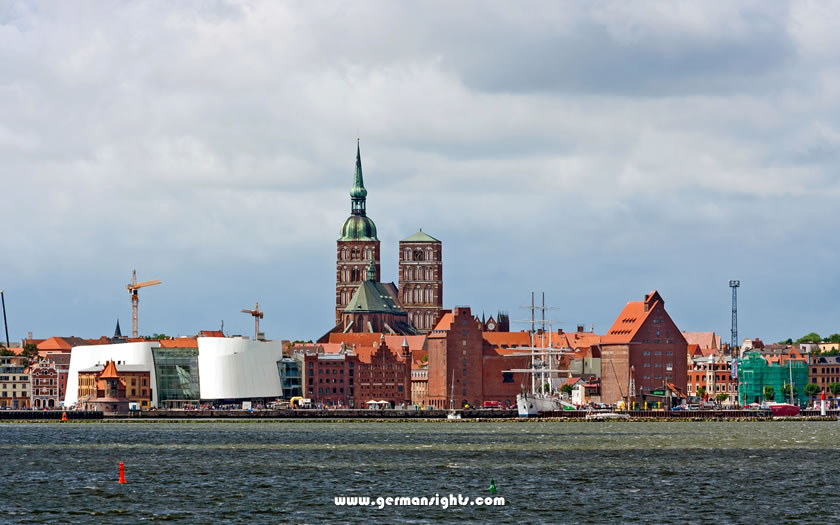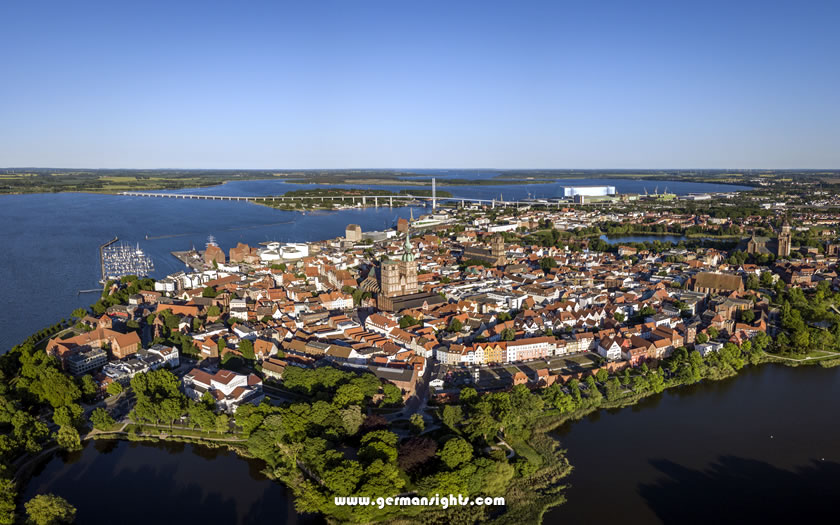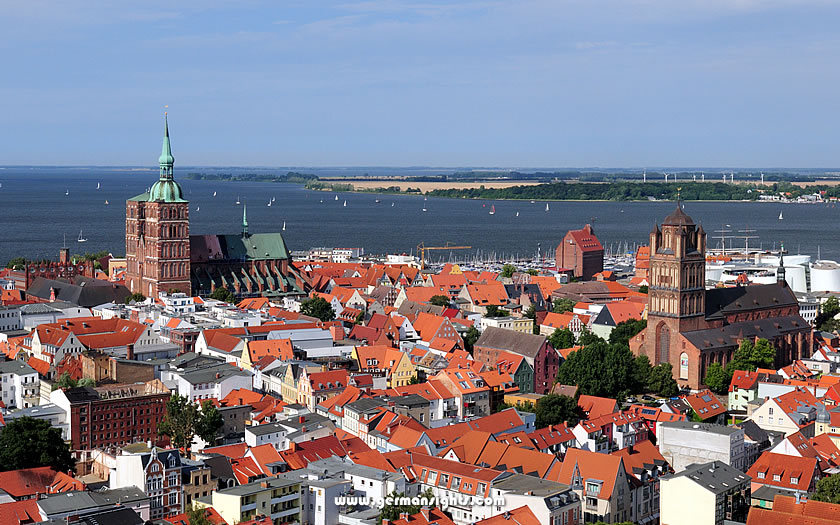Stralsund commands attention from the moment visitors see its brick Gothic towers rising above the Baltic Sea. This Hanseatic city's intact merchant houses, monumental churches, and restored waterfront complexes are a testament to the medieval prosperity of northern Germany's maritime trade.
While many travellers overlook Stralsund in favour of more popular destinations, those who venture here will discover one of Germany's most authentic historic ports.
The city's location on the Strelasund gives it an island-like feel, with water views from many vantage points.

View across the water to Stralsund
Unlike many heavily rebuilt German cities, Stralsund retained much of its original architecture during the Second World War, and its preservation has earned it the status of a UNESCO World Heritage site.
Modern Stralsund harbour still functions as a working port, while the former brewery now houses the acclaimed Ozeaneum aquarium.
The city's manageable size allows visitors to explore it thoroughly in two to three days, although many use it as a convenient base for exploring the island of Rügen or the Baltic coast.
Stralsund is located on Germany's Baltic coast in the state of Mecklenburg-Western Pomerania, 270 kilometres north of Berlin.
The city occupies a strategic position on the Strelasund Strait, a narrow body of water that separates mainland Germany from Rügen, the country's largest island. This location has historically controlled access to both the Baltic Sea and the important trade routes to Scandinavia.

Aerial view of Stralsund and the bridge to Rügen island
The city's connection to the island of Rügen is particularly important for visitors. A modern bridge, the Rügenbrücke, spans the Strelasund Strait, providing easy access to Germany's premier Baltic resort island.
This proximity to Rügen, combined with good rail and road links to Berlin and Hamburg, makes Stralsund an ideal base for exploring Germany's northeastern coastal region.
The nearby cities of Rostock and Lübeck both have international airports, although the choice of international destinations is limited.
Distance to Rostock Airport: 106km
Distance to Lübeck Airport: 211km
Distance to
Hamburg Airport: 281km
Distance to Berlin Brandenburg Airport: 304km
Distance to Copenhagen Airport: 214km (includes ferry and international transit through Sweden)
Hamburg airport and Berlin Brandenburg airport are options with plenty of European and long-haul destinations and international carriers. Transport from both is convenient by both road and rail services.
Copenhagen is another international airport within reach, although routes either through Denmark (via Rostock) or both Denmark and Sweden (direct to Stralsund) both involve ferry journeys.
Stralsund's main railway station ('Stralsund Hauptbahnhof') is located just outside the historic city centre across the water on the Tribseer Damm.
It is an important transit point for rail services on the Baltic coast and can offer InterCity services from cities around Germany. Regional train services connect Stralsund with Berlin, Rostock and Wittenberg, as well as accessing a number of towns on Rügen island.
Stralsund is linked to the major cities by the A20 motorway, which runs east-west along the Baltic coast.
Drivers from Berlin usually take the A11 north and then the A20 through Neubrandenburg. The route from Hamburg follows the A1 to Lübeck and then the A20 east. Both cities are around three hours away.
Parking in Stralsund requires planning, as access to the historic centre is restricted. There are several well-signposted car parks around the old town, with the Ozeaneum Stralsund car park being particularly convenient.
The island of Hiddensee can be reach by passenger ferry from Stralsund. (Rügen island is reached by the Rügenbrücke bridge or via the rail connections.)
If you know when you are planning to go but haven't decided on accommodation, then use the map below to get an idea of which properties are available and to compare prices during the period you wish to travel.
Enter your proposed dates and use the '+' to zoom in on a location and reveal more properties. Click on the price above a property to see more information.
(Please note that this selection will also include some guesthouses, pensions and self-catering apartments for those who are interested in that form of accommodation!)
Alternatively, if you would like a list of properties available on your proposed dates of travel, use the search box below to find accommodation:
Stralsund was established in 1234, when it received its city charter from Prince Wizlaw I of Rügen.
It quickly became one of the most influential trading centres in the Baltic. The city's strategic location between the German mainland and the island of Rügen made it a natural hub for maritime trade.
The powerful Hanseatic League trading alliance brought unprecedented wealth and influence to Stralsund.
The 14th century marked Stralsund's golden age, when wealthy merchants built impressive warehouses and Gothic churches that still dominate the skyline.
The city's power peaked in 1370 with the Peace of Stralsund, a treaty that confirmed the Hanseatic League's dominance over Baltic trade and secured Stralsund's position as one of northern Europe's most prosperous ports.
This period saw the development of the city's distinctive architectural character, with soaring church spires and elaborate merchant houses reflecting both its economic power and cultural sophistication.

St Nicholas church and the Jakobikirche with Rügen island in the background
The Thirty Years' War (1618-1648) brought significant changes to Stralsund. The city successfully resisted a siege by Wallenstein's imperial forces in 1628, with the help of Swedish troops.
This defence led to a long period of Swedish rule from 1648 to 1815. Under Swedish administration, Stralsund served as the administrative centre for Swedish Pomerania, leaving a lasting Scandinavian influence on the city's culture and architecture.
The Swedish period also saw the construction of new defensive works and public buildings, many of which are still visible today.
The 19th century brought both challenges and changes. After becoming part of Prussia in 1815, Stralsund gradually lost its special trading privileges, but developed new industries and modernised its infrastructure.
The arrival of the railway in 1863 connected the city to the growing German rail network, while fishing and shipbuilding became increasingly important to the local economy.
World War II left Stralsund remarkably intact compared to many other German cities. The post-war period under East German administration saw some neglect of historic buildings, but also protected the old town from excessive modern development.
Major restoration work since German reunification in 1990 has revitalized the city's architectural treasures, culminating in the 2002 inscription of Stralsund as a UNESCO World Heritage Site, recognizing the city's exceptional preservation of Hanseatic urban design and brick Gothic architecture.
The heart of the city's appeal lies in the UNESCO-listed Old Town of Stralsund, where the Old Market Square is a natural starting point for exploration.
This spacious medieval square is home to the city's most famous building, the Stralsund Town Hall, a masterpiece of 13th-century brick Gothic architecture. Its elaborate facade, with intricate blind arcades and decorated gables, represents the pinnacle of Hanseatic architectural achievement.

The Alter Markt and Stralsund town hall at twilight
Visitors can tour the interior of the building, where the historic assembly hall and exhibition rooms provide an insight into the city's government over the centuries.
The city's ecclesiastical heritage is illustrated by three monumental brick Gothic churches that dominate the skyline.
St Nicholas church, the oldest, has an astronomical clock and Baroque altar, while St Mary's boasts the world's largest Baroque organ. The Jakobikirche (Church of St James), though more modest, offers a peaceful retreat and beautiful medieval frescoes.
The Ozeaneum was opened in 2008 and represents the modern face of Stralsund, while paying tribute to its maritime heritage. This striking contemporary building houses one of Europe's most impressive aquariums, showcasing life from the Baltic Sea and Arctic environments.
The dramatic architecture of the complex, with its white facade resembling billowing sails, contrasts beautifully with the historic setting and offers spectacular views of the harbour.
The interior features massive tanks showcasing Nordic marine life, while interactive exhibits explain marine conservation and the effects of climate change.
The historic port area along the waterfront reveals Stralsund's trading past through well-preserved warehouses and the Maritime Museum, housed in a former monastery. The museum's maritime history collection includes detailed ship models, navigational instruments and exhibits explaining the Hanseatic trade routes.
Nearby, the Gorch Fock I, a restored 1933 sailing ship, serves as a floating museum, allowing visitors to experience life on board a traditional tall ship.
The city walls and fortifications form an attractive walking tour of the old town. Three medieval gates remain, the most photogenic of which is the imposing Kniepertor. The 13th-century Kütertor is home to a cultural centre, while sections of the city wall have viewing platforms overlooking the Strelasund Strait.
The Stralsund Museum in Mönchstraße displays a preserved merchant's house for those interested in how everyday life was in the Hanseatic town. The building reveals how wealthy merchants lived and worked, with their distinctive stepped gables and interior layouts retaining their medieval character.
The Stralsund Harbour Festival is usually held in early summer and celebrates the maritime history of the city, with sailing displays, races with dragon boats (and plastic ducks!) and live music.
This annual 17th-century reenactment festival, held in late July, commemorates Stralsund's defense against General Wallenstein's siege during the Thirty Years' War. The city centre is transformed with medieval markets, costumed parades and live re-enactments. It is one of the biggest and most colourful festivals in northern Germany.
Stralsund hosts a Christmas Market on the Alter Markt during the Advent period. Stalls selling handcrafted gifts, traditional ornaments, and seasonal treats fill the square beneath the illuminated town hall. The aromas of roasted almonds, mulled wine, and freshly baked stollen add to the festive attractions. It's the perfect time for a winter stroll.
The Stralsund tourist information office is located on the Alter Markt square in the historic town centre. It is open every day in summer, with slightly restricted hours at the weekends, and closed on Sundays during the winter period.
Website: www.stralsundtourismus.de